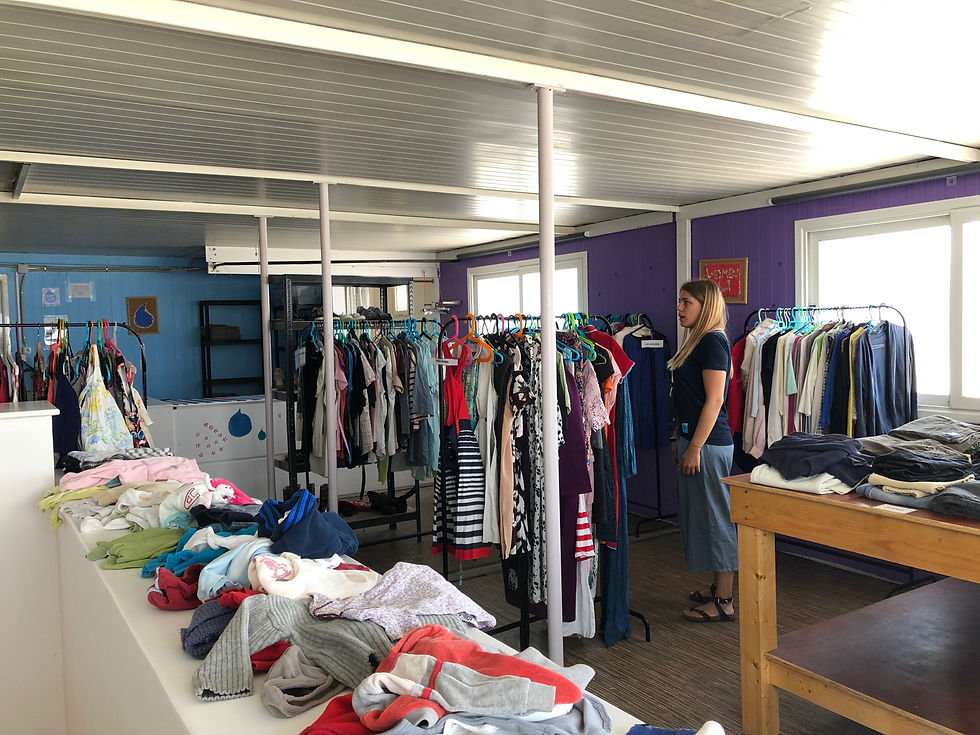Skaramangas: a model camp?
- AIDER-Help&Hope

- Jul 14, 2020
- 4 min read


Arriving in Greece with a car crammed with donations from our friends in France we needed to unload quickly, we had decided to take this year’s cargo to the camps Elefsina and Skaramangas to which we have been sending women’s sanitary products. These two camps are situated in the industrial, very polluted port and refinery area on the outskirts of Piraeus.At the beginning of the refugee crisis in Greece I had often read about the terrible conditions of Skaramangas camp, so I was particularly interested to visit this camp which today has been described as a model for a camp in Greece. The camp is closed to casual visitors, but as I had already sent our passport details to Giulia, camp co-ordinator for the organisation "A Drop in the Ocean (Drâpen i Havet)." Giulia met us at the gate and after inspection by the guards we were allowed to proceed along the inner wall of the high barbed wire fencing that makes so many camps in Greece ressemble a concentration camp more than a place of refuge.
A Drop in the Ocean (Drâpen i Havet) is a volunteer organisation and was founded by a Norweigan lady in 2015 in response to refugee crisis on Lesvos and which has since expanded having groups of volunteers in Skaramangas and Elefsina camps near Piraeus, Nea Kavala in the north, and on the island of Samos and Lesvos. On the mainland they are responsable for the distribution of clothes and other needed items and organise activities for the residents. On Lesvos Giulia and other volunteers have been saving lives of people arriving on the rocky inhospitable shores. The other main group in this camp is an international NGO, the Danish Refugee Council (DRC) responsible for site management, support and legal advice, and protection. We parked the car by a container and Giulia helped us unload. Our boxes, all previously labelled were stored in the container ready to enter the “shop” when needed. This perfectly organised area where the camp residents can come to choose clothes distributes around 3000 items to about 750 people each week. Giulia then very kindly showed us around the whole camp and explained everything in detail.

There are officially 2600 registered residents of all ages, from the newborn babies I saw in the women’s private space to their grandparents of 90+, but Giulia says the real number is probably more like 2800. There are 439 habitable container-type units equipped with hot and cold water, air conditioning unit on the roof, electricity, kitchen and bathroom. Many of these little boxes are turned into welcoming homes, some even with little pot-gardens in front. Some of the residents open little shops, sell groceries, vegetables and there's even a hairdresser for the other residents.
Unfortunately there are also people living in tents, refugees recently arrived from the overcrowded islands including those who were considered amongst the most vulnerable!. Naturally, on arriving from Lesvos and Samos, to find themselves in such conditions even before toilets had even been installed resulted in angry and disillusioned newcomers. The school has even had to be momentarily closed to be able to house some of these newcomers.


We visited the beautiful little welcoming building built by volunteers and other “container” type conversions, a library, a sewing room and a kids activity room and a lovely room for women and their babies up to 3 years where a midwife was helping the newborns and their mums. English classes are given in a container for new arrivals, others go to greek schools.

The midwife helping with the newborn

The kid's activity room

The perfectly organised "Drop Shop" for free clothing

Little shops opened by residents

There is also a gym and a football pitch for sports when it is not too hot. I wondered about swimming possibilities, the camp borders the Gulf of Elefsina and a welcome sea breeze was blowing in on the day we were there but it was still very hot, the concrete shade-less environment must be almost unbearable in the height of the greek summer. However, the sea looked opaque and oily,very different from the clear Aegean blue we know, and apart from lack of beach access, it didn’t look too advisable to risk a swim in these waters, quite obviously polluted due to the proximity of the oil refineries and other industries!

It is obvious that asylum seekers that have a place in one of the housing units in Skaramangas camp are luckier than the thousands of unfortunate ones crammed into overcrowded camps on the islands, in one of the terrible detention centers or sleeping in the streets of Athens… However many families have been in this camp for over two years, waiting for their asylum claims to be processed and there are many children that have known nothing but life as a refugee. Giulia and other dedicated volunteers are doing a wonderful and absolutely essential job, both here and all over Greece, a job only made possible by the generosity of donors. They are working hard trying to keep hope alive, helping to prevent complete despair for these people who have lost everything, have so little to fill their days and seemingly little prospect of a brighter future. At the end of our very interesting two hour visit we thanked Giulia for her time and kindness, we wished her and the residents well, hoping to be able to continue for as long as necessary our association’s small contributions to helping them with much needed items.

A last message from the children.



Comments